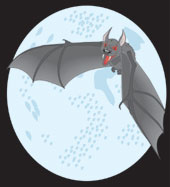 |
KnowHOW team explains: There are some bats that are active at least part of the time in daylight, but most are nocturnal or crepuscular, that is, night creatures, or denizens of the twilight.
There are at least two theories about how this adaptation evolved, involving the benefits of reduced competition for food at night and avoiding the diurnal animals that are the bats’ own predators.
Natural enemies of bats include snakes, owls, falcons and an Asian bird called the bat hawk. Some Jamaican fruit bats even avoid bright moonlight, when owls may also be on their wings.
Most bats spend the daytime hanging in clusters in trees or caves, inconspicuous and out of the way of birds of prey.
There are two major groups in the bat order, Chiroptera. The smaller ones, called microchiropterans, navigate and pursue nocturnal insects with their familiar sonarlike echolocation, squeaks that echo off other bodies.
The larger species, called megachiropterans, do not use echolocation, but have a good sense of smell for finding fruit and nectar and may have large, well-developed eyes to help them navigate in darkness or partial darkness. They are also called fruit bats, and some species are able to travel easily in the daytime.
The question was sent by Srila Sengupta from Calcutta-91










